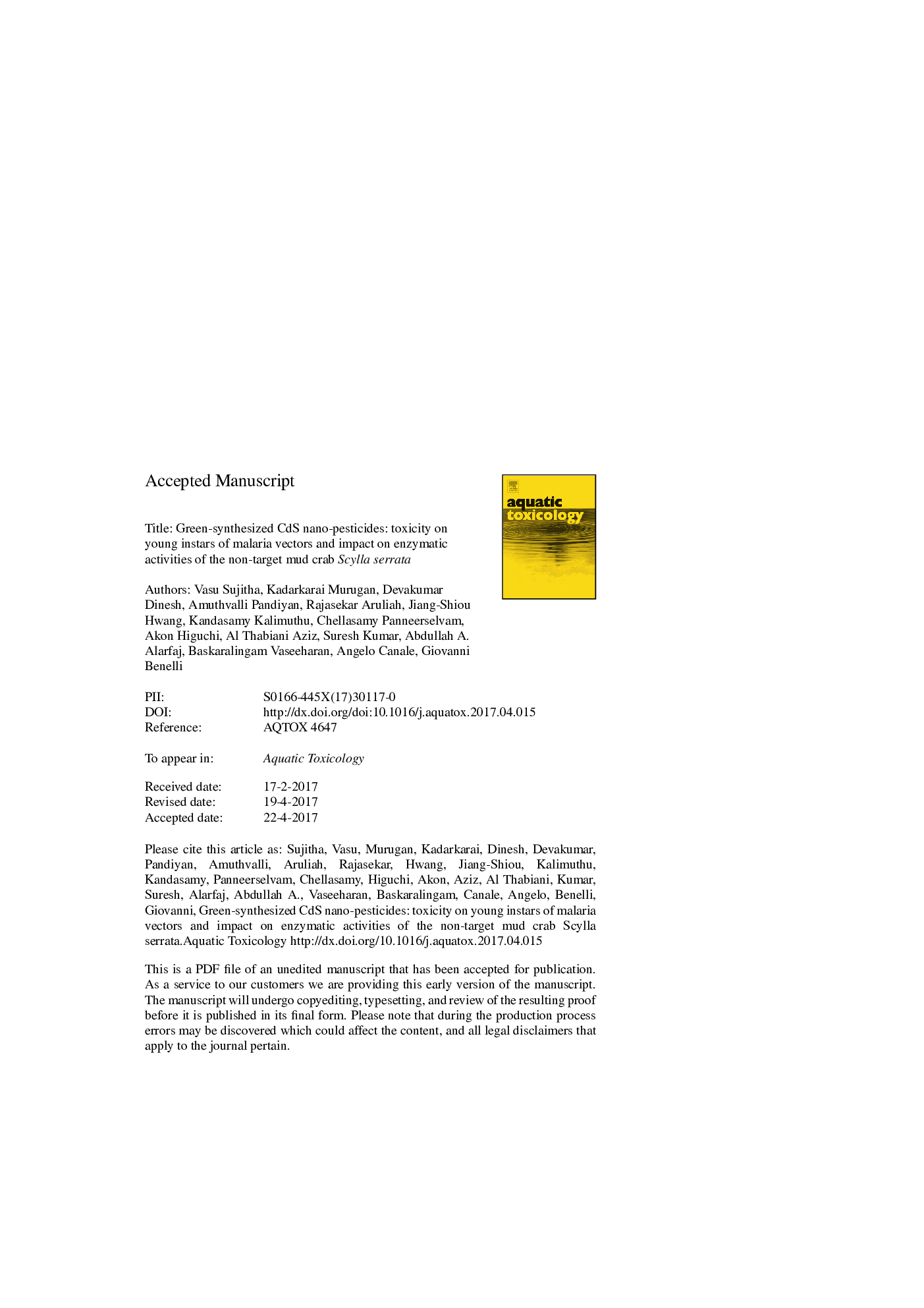| کد مقاله | کد نشریه | سال انتشار | مقاله انگلیسی | نسخه تمام متن |
|---|---|---|---|---|
| 5764226 | 1625917 | 2017 | 42 صفحه PDF | دانلود رایگان |
عنوان انگلیسی مقاله ISI
Green-synthesized CdS nano-pesticides: Toxicity on young instars of malaria vectors and impact on enzymatic activities of the non-target mud crab Scylla serrata
دانلود مقاله + سفارش ترجمه
دانلود مقاله ISI انگلیسی
رایگان برای ایرانیان
کلمات کلیدی
موضوعات مرتبط
علوم زیستی و بیوفناوری
علوم کشاورزی و بیولوژیک
علوم آبزیان
پیش نمایش صفحه اول مقاله

چکیده انگلیسی
Currently, nano-formulated mosquito larvicides have been widely proposed to control young instars of malaria vector populations. However, the fate of nanoparticles in the aquatic environment is scarcely known, with special reference to the impact of nanoparticles on enzymatic activity of non-target aquatic invertebrates. In this study, we synthesized CdS nanoparticles using a green protocol relying on the cheap extract of Valoniopsis pachynema algae. CdS nanoparticles showed high toxicity on young instars of the malaria vectors Anopheles stephensi and A. sundaicus. The antimalarial activity of the nano-synthesized product against chloroquine-resistant (CQ-r) Plasmodium falciparum parasites was investigated. From a non-target perspective, we focused on the impact of this novel nano-pesticide on antioxidant enzymes acetylcholinesterase (AChE) and glutathione S-transferase (GST) activities of the mud crab Scylla serrata. The characterization of nanomaterials was carried out by UV-vis and FTIR spectroscopy, as well as SEM and XRD analyses. In mosquitocidal assays, LC50 of V. pachynema-synthesized CdS nanoparticles on A. stephensi ranged from 16.856 (larva I), to 30.301 μg/ml (pupa), while for An. sundaicus they ranged from 13.584 to 22.496 μg/ml. The antiplasmodial activity of V. pachynema extract and CdS nanoparticles was evaluated against CQ-r and CQ-sensitive (CQ-s) strains of Plasmodium falciparum. IC50 of V. pachynema extract was 58.1 μg/ml (CQ-s) and 71.46 μg/ml (CQ-r), while nano-CdS IC50 was 76.14 μg/ml (CQ-s) and 89.21 μg/ml (CQ-r). In enzymatic assays, S. serrata crabs were exposed to sub-lethal concentrations, i.e. 4, 6 and 8 μg/ml of CdS nanoparticles, assessing changes in GST and AChE activity after 16 days. We observed significantly higher activity of GST, if compared to the control, during the whole experiment period. In addition, a single treatment with CdS nanoparticles led to a significant decrease in AChE activity over time. The toxicity of CdS nanoparticles and Cd ions in aqueous solution was also assessed in mud crabs, showing higher toxicity of aqueous Cd ions if compared to nano-CdS. Overall, our results underlined the efficacy of green-synthesized CdS nanoparticles in malaria vector control, outlining also significant impacts on the enzymatic activity of non-target aquatic organisms, with special reference to mud crabs.
ناشر
Database: Elsevier - ScienceDirect (ساینس دایرکت)
Journal: Aquatic Toxicology - Volume 188, July 2017, Pages 100-108
Journal: Aquatic Toxicology - Volume 188, July 2017, Pages 100-108
نویسندگان
Vasu Sujitha, Kadarkarai Murugan, Devakumar Dinesh, Amuthvalli Pandiyan, Rajasekar Aruliah, Jiang-Shiou Hwang, Kandasamy Kalimuthu, Chellasamy Panneerselvam, Akon Higuchi, Al Thabiani Aziz, Suresh Kumar, Abdullah A. Alarfaj, Baskaralingam Vaseeharan,